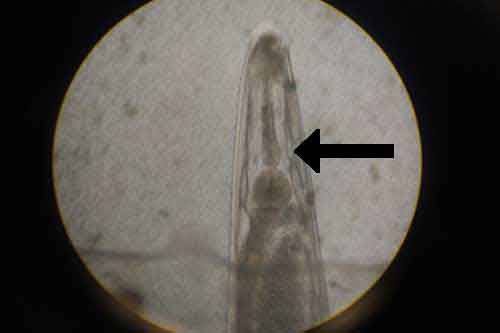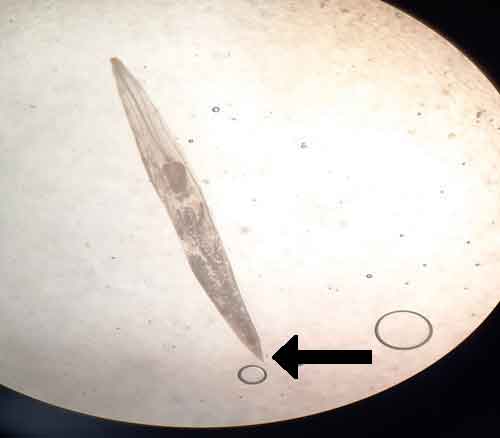INTRODUCTION
Nematodes are common in digestive system of tortoise and oxyurids(pinworm) are common in the colon of tortoises, although they are usually non-pathogenic. Worms have long tapering tail end, so called as pinworm. Clinical signs of anorexia, regurgitation, obstruction have been attributed to the presence of such parasites.
PRESENTATION
The massive parasitation by Oxyuridae parasites in a 10-year-old female Indian star tortoise (Geochelone elegans) is presented with mild symptoms like;
- Inappetence
- Dullness
- Passing worms in feces
CLINICAL FINDINGS
Upon clinical examination, the tortoise was dull and had low weight, and was dehydrated and cachectic. The eyes were sunken in the orbits. The limb movements were diminished. The parasites were whitish, measuring about 4-6 mm in length passes with feces.

DIAGNOSTIC TESTS
All parasites were removed from the cloaca and from passed feces for microscopic analysis. Parasites were measured, photographed, and preserved in alcohol. The length of the collected worms varied from 4-6mm.
Coprological study: One-gram fresh feces sampled for coprological study. Coprological analysis was performed by sedimentation method. Using this technique, it is confirmed that all eggs were of Oxyuridae species. Typical characters of pinworm eggs are,
- Thin walled
- D – shaped
- Distinctly flattened on one side

Microscopic examination of adult worms: Collected parasites are identified on the basis of shape of adult worms and its typical microscopic characteristics like,
- Normal length of adult worms: Male: 3-4 mm, Female: 6-8 mm
- Presence of prominent esophageal bulb towards anterior end on microscopic examination.
- Adult male worms have relatively blunt posterior end with single spicule.
- Adult female worms have long, pointed tail end leading to the common name pinworm.



TREATMENT
In order to treat the infection of pinworm, Albendazole @ 50mg/Kg body weight was given orally for 2 days along with vitamin and mineral supplements.
OUTCOME
A tortoise recovered after a week. It began to eat and improve in weight. Coprological analysis was repeated after week and feces was examined microscopically. It was negative for pinworm infection.
DISCUSSION
Nematodes are common in the digestive system of tortoises and especially in Indian star tortoise. Nematode overload is commonly encountered in reptiles housed in poor conditions. Oxyurids are common in the colon of tortoises, although they are usually non-pathogenic. However, impaction due to oxyurid infection may occur in severe cases. In these cases, a large number of parasites were found during necropsy in stomach, intestine, and colon.
Clinical signs of anorexia, regurgitation, obstruction, and abdominal distension have been attributed to the presence of such parasites in these cases. Abdominal distension is an undetectable sign in tortoises due to the presence of the shell. Although anorexia and starvation were observed in the present case, they are a common signs of diseases and not specific to parasites.
Occupants of the intestinal lumen such as pinworms (Oxyuridae) deprive the host of important nutrients. In young reptiles, growth disturbances may be seen, and the fertility rate in females drops.
Albendazole can be given for treating nematode infections in reptiles. It can be administered per cloacally as a liquid, or the powdered form can be placed on food. In continued treatment, the liquid form can be given by the gastric catheter used in forced feeding.
Albendazole is a benzimidazole drug used to treat many reptile parasites, mainly involving pinworms (Oxyuridae), ascaris, acanthocephalan, Heterakis, Strongyloides and liver flukes (Dicrocoelium and Fasciola). All of these parasites are frequent in an exotic animals, so albendazole use on reptiles is very common.
Reference
- Albert martinaze-silvestre
- C.R.A.R.C. barcelona Spain
|
The content of the articles are accurate and true to the best of the author’s knowledge. It is not meant to substitute for diagnosis, prognosis, treatment, prescription, or formal and individualized advice from a veterinary medical professional. Animals exhibiting signs and symptoms of distress should be seen by a veterinarian immediately. |






Nice article akash
Very informative Article…
All the best…